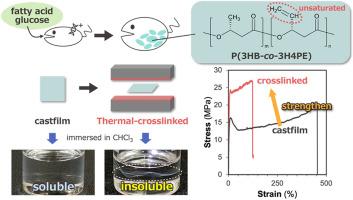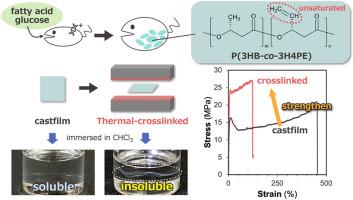Thermal cross-linking mechanism of polyhydroxyalkanoates with vinyl unit in their side chains
IF 4.5
2区 化学
Q2 POLYMER SCIENCE
引用次数: 0
Abstract
Poly[(R)-3-hydroxybutyrate-co-(R)-3-hydroxy-4-pentenoate] (P(3HB-co-3H4PE)), a microbial polyester containing an unsaturated group (vinyl group) in the side chain, was employed to prepare cross-linked materials. Upon testing UV-induced and heat-induced cross-linking, it was found that P(3HB-co-3H4PE) undergoes thermal cross-linking without cross-linking agent in crystal region. The thermal cross-linking occurs within a specific temperature range below the melting point and only when crystals are present in the material. As a result of the cross-linking effect, the strength of the material was improved. Since no cross-linking occurs at temperatures above the melting point, like other polyhydroxyalkanoate copolymers, it is possible to process it by molding, and post-cross-linking can further enhance the material's strength. The cross-linking of this PHA with an unsaturated group will likely open up the possibility for even stronger or higher heat resistance PHA materials.


侧链含乙烯基的聚羟基烷酸酯的热交联机理
聚[(R)-3-羟基丁酸酯-co-(R)-3-羟基-4-戊酸酯](P(3HB-co-3H4PE))是一种侧链上含有不饱和基(乙烯基)的微生物聚酯,用于制备交联材料。通过紫外诱导交联和热诱导交联测试,发现P(3HB-co-3H4PE)在晶体区域无交联剂的情况下发生了热交联。在低于熔点的特定温度范围内,只有当材料中存在晶体时,才会发生热交联。由于交联效应,材料的强度得到了提高。由于在熔点以上的温度下不会像其他聚羟基烷酸酯共聚物那样发生交联,因此可以通过成型处理,并且交联后可以进一步提高材料的强度。这种PHA与不饱和基团的交联可能会为更强或更高耐热性的PHA材料开辟可能性。
本文章由计算机程序翻译,如有差异,请以英文原文为准。
求助全文
约1分钟内获得全文
求助全文
来源期刊

Polymer
化学-高分子科学
CiteScore
7.90
自引率
8.70%
发文量
959
审稿时长
32 days
期刊介绍:
Polymer is an interdisciplinary journal dedicated to publishing innovative and significant advances in Polymer Physics, Chemistry and Technology. We welcome submissions on polymer hybrids, nanocomposites, characterisation and self-assembly. Polymer also publishes work on the technological application of polymers in energy and optoelectronics.
The main scope is covered but not limited to the following core areas:
Polymer Materials
Nanocomposites and hybrid nanomaterials
Polymer blends, films, fibres, networks and porous materials
Physical Characterization
Characterisation, modelling and simulation* of molecular and materials properties in bulk, solution, and thin films
Polymer Engineering
Advanced multiscale processing methods
Polymer Synthesis, Modification and Self-assembly
Including designer polymer architectures, mechanisms and kinetics, and supramolecular polymerization
Technological Applications
Polymers for energy generation and storage
Polymer membranes for separation technology
Polymers for opto- and microelectronics.
 求助内容:
求助内容: 应助结果提醒方式:
应助结果提醒方式:


